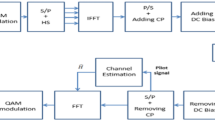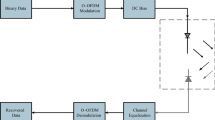Abstract
An investigation on the orthogonal frequency division multiplexing (OFDM) equalization using deep learning architectures for a multipath single-input single-output visible light communication (VLC) channel is presented in this work. Convolution neural networks (CNN) architectures are applied in a direct OFDM mapped symbols equalization, without channel estimation, interpolation nor element-wised division, denominated CNN-Direct Equalization (CNN-DE). The performance analysis of the proposed equalizer is evaluated by considering the mean square error, bit error rate (BER), and error vector magnitude, over different signal-to-noise ratio (SNR) scenarios. Simulation results show that the proposed CNN-DE outperforms the least-square channel estimation (LS) for lower values of SNR (lower than 10 dB), which validates the CNN-DE application for noisy channels. The CNN-DE performs similarly as LS-based equalization, in terms of BER, when the LED non-linear effects and a more realistic VLC channel are taken into consideration.












Similar content being viewed by others
References
Rohling, H.: OFDM: Concepts For Future Communication Systems. Springer Science & Business Media, Berlin (2011)
Kabir, W.: Orthogonal frequency division multiplexing (OFDM). In: 2008 China–Japan Joint Microwave Conference, pp. 178–184 (2008). https://doi.org/10.1109/CJMW.2008.4772401
Kumar, A., NandhaKumar, P.: OFDM system with cyclostationary feature detection spectrum sensing. ICT Express 5(1), 21 (2019)
Zaidi, A.A., Baldemair, R., Moles-Cases, V., He, N., Werner, K., Cedergren, A.: OFDM numerology design for 5G new radio to support IoT, eMBB, and MBSFN. IEEE Commun. Stand. Mag. 2(2), 78 (2018)
Zhang, X., Yuan, Z.: The application of interpolation algorithms in OFDM channel estimation. Int. J. Simul. Syst. Sci. Technol. 17, 11 (2016)
Coleri, S., Ergen, M., Puri, A., Bahai, A.: Channel estimation techniques based on pilot arrangement in OFDM systems. IEEE Trans. Broadcast. 48(3), 223 (2002)
Balevi, E., Andrews, J.G.: Deep Learning-Based Channel Estimation for High-Dimensional Signals. arXiv preprint arXiv:1904.09346 (2019)
Picorone, A.A.M., Oliveira, T.R., Ribeiro, M.V.: PLC channel estimation based on pilots signal for OFDM modulation: a review. IEEE Lat. Am. Trans. 12(4), 580 (2014)
Van De Beek, J.J., Edfors, O., Sandell, M., Wilson, S.K., Borjesson, P.O.: On channel estimation in OFDM systems. In: 1995 IEEE 45th Vehicular Technology Conference. Countdown to the Wireless Twenty-First Century, vol. 2, pp. 815–819 (1995)
Soltani, M., Pourahmadi, V., Mirzaei, A., Sheikhzadeh, H.: Deep learning-based channel estimation. IEEE Commun. Lett. 23(4), 652 (2019). https://doi.org/10.1109/LCOMM.2019.2898944
Ye, H., Li, G.Y., Juang, B.H.: Power of deep learning for channel estimation and signal detection in OFDM systems. IEEE Wirel. Commun. Lett. 7(1), 114 (2017)
Ahmad, S.T., Kumar, K.P.: Radial basis function neural network nonlinear equalizer for 16-QAM coherent optical OFDM. IEEE Photonics Technol. Lett. 28(22), 2507 (2016)
Giacoumidis, E., Le, S., Aldaya, I., Wei, J., McCarthy, M., Doran, N., Eggleton, B.: Experimental comparison of artificial neural network and Volterra based nonlinear equalization for CO-OFDM. In: Optical Fiber Communication Conference, pp. W3A–4 (2016)
Huang, H., Yang, J., Huang, H., Song, Y., Gui, G.: Deep learning for super-resolution channel estimation and DOA estimation based massive MIMO system. IEEE Trans. Veh. Technol. 67(9), 8549 (2018)
Jiang, R., Wang, X., Cao, S., Zhao, J.: Deep neural networks for channel estimation in underwater acoustic OFDM systems. IEEE Access 7, 23579 (2019). https://doi.org/10.1109/ACCESS.2019.2899990
Zhang, Y., Li, J., Zakharov, Y., Li, X., Li, J.: Deep learning based underwater acoustic OFDM communications. Appl. Acoust. 154, 53 (2019). https://doi.org/10.1016/j.apacoust.2019.04.023
Wu, X., Huang, Z., Ji, Y.: Deep neural network method for channel estimation in visible light communication. Opt. Commun. 462, 125272 (2020)
Aoudia, F.A., Hoydis, J.: End-to-end learning for OFDM: from neural receivers to pilotless communication. IEEE Trans. Wirel. Commun. (2021). https://doi.org/10.1109/TWC.2021.3101364
Costa, W.S., Samatelo, J.L., Rocha, H.R., Segatto, M.E., Silva, J.A.: Direct equalization with convolutional neural networks in OFDM based VLC systems. In: 2019 IEEE Latin-American Conference on Communications (LATINCOM), pp. 1–6 (2019)
Lipton, Z.C., Berkowitz, J., Elkan, C.: A critical review of recurrent neural networks for sequence learning. arXiv preprint arXiv:1506.00019 (2015)
Goodfellow, I., Bengio, Y., Courville, A.: Deep Learning. MIT press, Cambridge (2016)
Bazgir, O., Zhang, R., Dhruba, S.R., Rahman, R., Ghosh, S., Pal, R.: Representation of features as images with neighborhood dependencies for compatibility with convolutional neural networks. Nat. Commun. 11(1), 1 (2020)
Chen, W., Qi, L., Yanjun, F.: An improved least square channel estimation algorithm for underwater acoustic OFDM systems. In: 2010 2nd International Conference on Future Computer and Communication, vol. 3, pp. V3–577 (2010)
Ghassemlooy, Z., Popoola, W., Rajbhandari, S.: Optical Wireless Communications: System and Channel Modelling with Matlab®. CRC Press, Boca Raton (2019)
Monteiro, F.T., Costa, W.S., Neves, J.L., Silva, D.M., Rocha, H.R., Salles, E.O., Silva, J.A.: Experimental evaluation of pulse shaping based 5G multicarrier modulation formats in visible light communication systems. Opt. Commun. 457, 124693 (2020)
Costa, W., Camporez, H., Segatto, M., Rocha, H., Silva, J.: Towards AI-enhanced VLC systems. In: Optical Fiber Communication Conference, pp. W3I–7 (2022)
Qiu, Y., Chen, H.H., Meng, W.X.: Channel modeling for visible light communications—a survey. Wirel. Commun. Mob. Comput. 16(14), 2016 (2016)
vd Zwaag, K.M., Neves, J.L., Rocha, H.R., Segatto, M.E., Silva, J.A.: Adaptation to the LEDs flicker requirement in visible light communication systems through CE-OFDM signals. Opt. Commun. 441, 14 (2019)
Aloysius, N., Geetha, M.: A review on deep convolutional neural networks. In: 2017 International Conference on Communication and Signal Processing (ICCSP), pp. 0588–0592 (2017)
O’Shea, K., Nash, R.: An introduction to convolutional neural networks. arXiv preprint arXiv:1511.08458 (2015)
Kiranyaz, S., Ince, T., Abdeljaber, O., Avci, O., Gabbouj, M.: 1-d convolutional neural networks for signal processing applications. In: ICASSP 2019-2019 IEEE International Conference on Acoustics, Speech and Signal Processing (ICASSP), pp. 8360–8364 (2019)
Kiranyaz, S., Avci, O., Abdeljaber, O., Ince, T., Gabbouj, M., Inman, D.J.: 1d convolutional neural networks and applications: a survey. Mech. Syst. Signal Process. 151, 107398 (2021)
Ioffe, S., Szegedy, C.: Batch normalization: accelerating deep network training by reducing internal covariate shift. arXiv preprint arXiv:1502.03167 (2015)
Nagi, J., Ducatelle, F., Di Caro, G.A., Cireşan, D., Meier, U., Giusti, A., Nagi, F., Schmidhuber, J., Gambardella, L.M.: Max-pooling convolutional neural networks for vision-based hand gesture recognition. In: 2011 IEEE International Conference on Signal and Image Processing Applications (ICSIPA), pp. 342–347 (2011)
Kingma, D.P., Ba, J.: Adam: a method for stochastic optimization. arXiv preprint arXiv:1412.6980 (2014)
Shafik, R.A., Rahman, M.S., Islam, A.R., Ashraf, N.S.: On the error vector magnitude as a performance metric and comparative analysis. In: 2006 International Conference on Emerging Technologies, pp. 27–31 (2006)
Yu, Z., Baxley, R.J., Zhou, G.T.: EVM and achievable data rate analysis of clipped OFDM signals in visible light communication. EURASIP J. Wirel. Commun. Netw. 2012(1), 321 (2012)
Caruso, C., Quarta, F.: Interpolation methods comparison. Comput. Math. Appl. 35(12), 109 (1998)
Zwaag, K.M.V.D., Marinho, M.P., Costa, W.D.S., De Assis Souza Dos Santos, F., Bastos-Filho, T.F., Rocha, H.R.O., Segatto, M.E.V., Silva, J.A.L.: A Manchester-OOK visible light communication system for patient monitoring in intensive care units. IEEE Access 9, 104217 (2021). https://doi.org/10.1109/ACCESS.2021.3099462
Elgala, H., Mesleh, R., Haas, H.: An LED model for intensity-modulated optical communication systems. IEEE Photonics Technol. Lett. 22(11), 835 (2010)
Foody, G.M.: Status of land cover classification accuracy assessment. Remote Sens. Environ. 80(1), 185 (2002)
Kłopotek, M. A., Wierzchoń, S. T., Trojanowski, K. (2004). (Eds.), Intelligent Information Processing and Web Mining. Springer Berlin, Heidelberg. https://doi.org/10.1007/978-3-540-39985-8
Acknowledgements
This work was partially supported by FAPES, CNPq and CAPES in the projects FAPES-2021-WMR44, NEsT-5 G-84343540, CNPq 309737/2021-4, 309490/2021-9 and OWIND, during a scholarship supported by the International Cooperation Program PIPC at the Technische Universität Berlin. Financed by Capes - Brazilian Federal Agency for Support and Evaluation of Graduate Education within the Ministry of Education of Brazil.
Author information
Authors and Affiliations
Corresponding author
Ethics declarations
Conflict of interest
The authors declare that they have no conflict of interest.
Additional information
Publisher's Note
Springer Nature remains neutral with regard to jurisdictional claims in published maps and institutional affiliations.
Rights and permissions
Springer Nature or its licensor (e.g. a society or other partner) holds exclusive rights to this article under a publishing agreement with the author(s) or other rightsholder(s); author self-archiving of the accepted manuscript version of this article is solely governed by the terms of such publishing agreement and applicable law.
About this article
Cite this article
Costa, W.S., Samatelo, J.L.A., Rocha, H.R.O. et al. CNN direct equalization in OFDM-VLC systems: evaluations in a numerical model based on experimental characterizations. Photon Netw Commun 45, 1–11 (2023). https://doi.org/10.1007/s11107-022-00987-7
Received:
Accepted:
Published:
Issue Date:
DOI: https://doi.org/10.1007/s11107-022-00987-7





